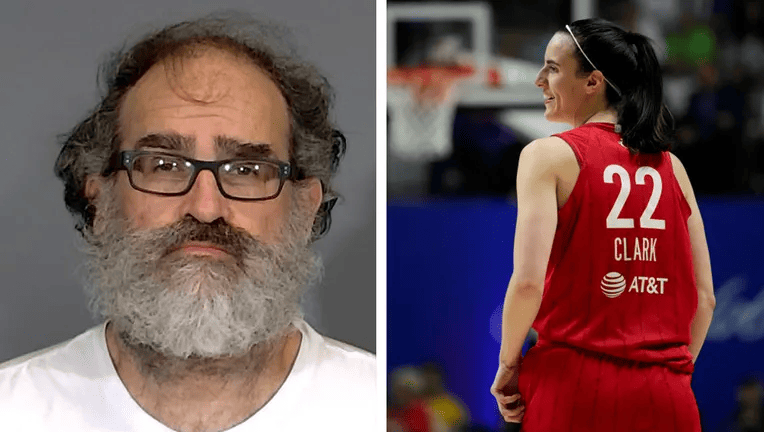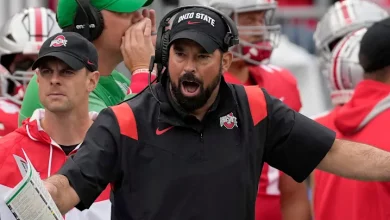Michael Lewis, a Texas man accused of stalking Caitlin Clark.

In a chilling turn of events, Michael Lewis, a Texas man, has been accused of stalking Caitlin Clark, a prominent figure in women’s basketball, most notably as a rising star with the Indiana Fever in the WNBA. Lewis is facing charges after allegedly sending her a series of frightening and unsolicited messages on social media, a case that has not only raised concerns for Clark’s safety but has also highlighted the increasing dangers of stalking, especially through digital platforms. This case brings to light a larger issue about the personal security of athletes, particularly women, who are in the public eye and subject to varying degrees of unwanted attention.
Caitlin Clark’s experience underscores the difficulties athletes face when navigating the fine line between fame and personal privacy. While Clark is celebrated for her on-court achievements and massive influence in women’s basketball, the reality of being a public figure comes with risks, particularly in a world where social media has created new avenues for harassment and stalking.
This article delves into the details of the stalking allegations against Michael Lewis, explores the broader issue of stalking and harassment faced by female athletes, and reflects on what can be done to prevent such incidents from happening in the future.
The Rise of Caitlin Clark: A Superstar in Women’s Basketball
Caitlin Clark’s rise to prominence in the world of women’s basketball has been extraordinary. From her days as a standout player for the Iowa Hawkeyes to becoming the first overall pick in the 2024 WNBA Draft by the Indiana Fever, Clark has captured the hearts of basketball fans everywhere. Known for her exceptional shooting ability, court vision, and leadership, Clark has become one of the most recognizable athletes in college sports, and her fame has only grown as she transitioned to the professional ranks.
Throughout her collegiate career, Clark shattered records and garnered numerous accolades, including NCAA Player of the Year honors and recognition as one of the best basketball players in the world. As a result, her visibility as a sports figure has increased dramatically. While this success is a testament to her hard work and talent, it also means that Clark is more exposed to the public than ever before.
For athletes like Clark, the line between being a public figure and maintaining a private life becomes increasingly difficult to navigate. As her career flourishes, Clark has gained not only admiration from fans but also the scrutiny and attention that come with such fame—attention that sometimes takes a darker turn.
The Allegations Against Michael Lewis
The accusations against Michael Lewis are disturbing. According to authorities, Lewis, a man from Texas, became fixated on Clark after following her career and sending her multiple direct messages on social media platforms. These messages quickly escalated from what may have initially seemed like harmless fan engagement to alarming threats and obsessive communications. According to law enforcement, Lewis reportedly made several concerning remarks to Clark, some of which referenced personal information that only someone with obsessive knowledge of her life could have known.
The messages included comments about her physical appearance, her career, and references to her personal life that were unsettling and intrusive. As the messages increased in frequency, they became more aggressive and threatening in tone, with Lewis allegedly demanding that Clark respond to him. At one point, the messages became so concerning that Clark felt compelled to take action by alerting both her legal team and local authorities.
Once the situation was reported, authorities were able to track the messages back to Lewis. Law enforcement officers subsequently charged him with stalking and harassment, marking a serious criminal case that could have significant consequences for him, should he be convicted. It is important to note that stalking and harassment are serious crimes that can have lasting effects on the victims, and in this case, Clark’s personal safety and well-being were compromised by these interactions.
The Psychological Impact of Stalking on Athletes
Stalking can have profound emotional and psychological effects on its victims, and athletes like Caitlin Clark are not exempt from its impact. While many people think of stalking as a crime that only affects individuals outside the public eye, the reality is that public figures, particularly women, are often disproportionately affected by such harassment.
For Clark, being a target of stalking likely induced feelings of anxiety, fear, and helplessness. As an athlete in the spotlight, Clark is already under immense pressure to perform, and dealing with the emotional fallout of being stalked only compounds that stress. Stalking often creates a sense of fear and vulnerability, as victims may feel they are being watched or pursued by someone who refuses to respect their boundaries. The inability to escape this constant harassment can lead to serious mental health issues, including post-traumatic stress disorder (PTSD), depression, and anxiety.
In addition to the emotional toll, the professional life of an athlete can also be affected. For Clark, the focus on her performance and career was temporarily interrupted by the need to address this personal safety issue. The emotional distress caused by being stalked can impact an athlete’s ability to concentrate, sleep, and maintain a healthy work-life balance. Mental health issues that stem from stalking are often overlooked in professional sports, but they are a real concern for athletes, who are expected to perform at their peak despite the personal challenges they may face.
The Digital Age and the Growing Threat of Cyberstalking
One of the most troubling aspects of the stalking case involving Michael Lewis is the fact that the harassment occurred via social media—an issue that has become more widespread with the advent of digital communication platforms. In the past, stalking was primarily a physical crime, where an individual would follow their target in person, often showing up at their home or workplace. However, with the rise of the internet, social media, and smartphones, stalking has increasingly shifted to digital spaces, giving perpetrators the ability to harass and stalk victims from anywhere in the world.
Cyberstalking, as it is now known, allows individuals to use online platforms to send threatening messages, spread rumors, and even gather information about their targets through their public profiles. Social media platforms like Twitter, Instagram, and Facebook have become places where stalkers can gain access to their targets, learning details about their personal lives through public posts, photos, and status updates.
For Caitlin Clark, as a high-profile athlete, social media has become a tool to connect with fans, promote her brand, and expand her public reach. However, it also makes her vulnerable to individuals like Michael Lewis, who can misuse these platforms to gain access to her personal life and attempt to control or manipulate the relationship through digital means. The constant barrage of online messages can feel overwhelming, and it’s easy for perpetrators to remain anonymous or use fake accounts to avoid detection, making it harder for law enforcement to track down the offenders.
The growing issue of cyberstalking is one that needs to be addressed by both social media platforms and the legal system. Social media companies must take stronger action to prevent harassment on their platforms, including removing threatening messages and blocking individuals who engage in abusive behavior. Meanwhile, the legal system must continue to evolve to address the unique challenges posed by cyberstalking, as digital harassment can be just as damaging as physical stalking.
Legal Consequences of Stalking and Harassment
The criminal charges facing Michael Lewis—stalking and harassment—are serious offenses. Stalking is defined as a pattern of behavior that causes a person to feel fear or distress, while harassment involves the intentional distressing or intimidating of another person. In this case, the frequency and severity of Lewis’s messages toward Clark meet the criteria for these offenses. If convicted, Lewis could face a range of legal consequences, including imprisonment, fines, and a criminal record.
The case against Lewis also serves as an important reminder about the need for stronger protections for athletes and public figures when it comes to stalking and harassment. Law enforcement must act quickly to investigate and address these crimes, ensuring that victims are given the support they need. Additionally, more resources should be allocated to help law enforcement agencies track down perpetrators who engage in online stalking, as these individuals often go undetected for long periods of time.
On a broader scale, this case raises questions about how social media platforms and sports organizations can collaborate to prevent stalking and harassment of athletes. Sports leagues like the WNBA, along with their affiliated teams, must establish protocols to protect their players from digital harassment, including offering them tools to manage and block harmful online interactions. These organizations also need to be proactive in educating both athletes and fans about appropriate behavior online, ensuring that there is a clear understanding of the consequences of stalking and harassment.
The Importance of Mental Health Support for Athletes
The stalking incident involving Caitlin Clark highlights the significant need for mental health support for athletes. While physical health is a priority in professional sports, the mental and emotional well-being of athletes is often overlooked. This is particularly true when it comes to issues like stalking and harassment, which can have a profound impact on an athlete’s ability to perform and lead a balanced life.
Athletes who experience stalking, especially digital harassment, need access to counseling services, mental health resources, and crisis intervention support. These services should be available not only to help victims cope with the immediate effects of stalking but also to support them in rebuilding their sense of safety and security. Mental health professionals should be trained to recognize the signs of trauma that can result from stalking, and they should be equipped to provide effective strategies for coping with anxiety, fear, and distress.









